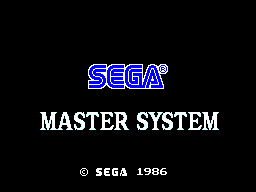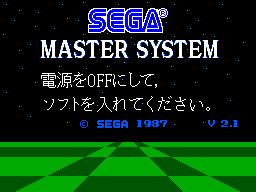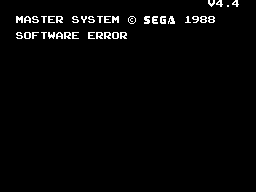Sega Master System BIOS
| Sega Master System BIOS |
|---|
|
Also known as: Gam*Boy (KR original), Aladdin Boy (KR later)
|
The Master System was Sega's first console released worldwide (if you don't include the SG-1000's release in Australia and New Zealand). While it didn't see as much success as Nintendo were having with their NES, it became a hit in Europe and an even larger hit in Brazil, where distributor TecToy releases new variants to this day.
Contents
Sub-Pages
| Prototype Info |
Version Differences
Built-In Games
Several different versions of the Master System BIOS contain built-in games, which are automatically launched if there is no cartridge/card inserted.
- US/EU v1.3 (1986): The original retail release. Features an instructional screen if no cartridge/card is detected.
- v2.0 (1987): An uncommon version, uncertain region. Does not check the inserted cartridge/card before running it.
- JP v2.1 (1987): Completely different bumper screen. Does not check the inserted cartridge/card before running to provide SG-1000/Mark III compatibility. The copyright on the bumper screen has been updated to 1987.
- US/EU v2.4 (1988) with Hang-On & Safari Hunt. The copyright on the boot screen has been updated to 1988.
- US/EU v3.4 (1988) with Hang-On.
- US/EU v4.4 (1988) with Missile Defense 3-D. Released in "Super System" bundles that did not have the game as a separate cart.
- US/EU (1990) with slightly altered version of Alex Kidd in Miracle World. Most commonly found on Master System II units, but known to have been shipped with very late-run Master System I units.
- EU Master System II (1991) with slightly altered version of Sonic the Hedgehog.
- KR Super Gam*Boy II/Aladdin Boy (1991?) with Alex Kidd in Miracle World.
Despite the Sonic and Korean versions of the BIOS only shipping on Master System II units, they both check the expansion port and card slot on boot despite the slots not being present on the Master System II. This may suggest that they were originally developed for Master System I units, or that the Master System II once had the expansion port and card slot.
Later Master System models released post-1990 use a more basic boot screen, only showing the Sega logo. Both revisions that use this style of boot screen display the Sega logo differently.
| Alex Kidd built-in | Sonic 1 built-in |
|---|---|
 |
 |
The screen for a "software error" (the inserted cartridge/card failed checksum verification) was also changed between v4.4 and the Alex Kidd revision. The font was slightly modified on the Sonic revision.
| US/Europe v4.4 | Alex Kidd built-in | Sonic 1 built-in |
|---|---|---|
Snail Maze
Certain revisions of the BIOS (v1.3, v2.4 and v3.4) included with Master System I units contain a hidden game upon pressing Up + 1 + 2 on Controller 1. In this game, dubbed Snail Maze, you control a snail and guide it through a maze within the given time limit. There are 12 mazes in total before the console resets.
In v1.3, the game is accessed with the aforementioned button combination on the instructional screen. On v2.4 and v3.4, the button combination has to be held during the Sega logo boot screen.
Regional Differences
Japanese Release
| US/Europe (v1.3) | Japan |
|---|---|
 |
 |
The Japanese Master System has the YM2413 FM chip built in, and features a unique BIOS screen featuring graphics and music from Space Harrier. This version also did not include any built-in software, and instructs the user to turn the console off and insert a game.
| Japanese | Translation |
|---|---|
電源をOFFにして、 ソフトを入れてください。 |
Turn the power switch to OFF, then please insert some software. |
Korean Release
| US/Europe (Alex Kidd built-in) | Korea |
|---|---|
 |
 |
The Korean version of the Master System was distributed by Samsung due to South Korea's ban of Japanese electronics at the time. Fittingly, Korean Master System units replace the Sega logo with Samsung's.
- Pages missing developer references
- Games developed by Sega
- Pages missing publisher references
- Games published by Sega
- Games published by Samsung
- Games published by Tec Toy
- Sega Master System games
- Pages missing date references
- Games released in 1986
- Games released in September
- Games with regional differences
- Games with revisional differences
- BIOS/Firmware ROMs
Cleanup > Pages missing date references
Cleanup > Pages missing developer references
Cleanup > Pages missing publisher references
Games > BIOS/Firmware ROMs
Games > Games by content > Games with regional differences
Games > Games by content > Games with revisional differences
Games > Games by developer > Games developed by Sega
Games > Games by platform > Sega Master System games
Games > Games by publisher > Games published by Samsung
Games > Games by publisher > Games published by Sega
Games > Games by publisher > Games published by Tec Toy
Games > Games by release date > Games released in 1986
Games > Games by release date > Games released in September


